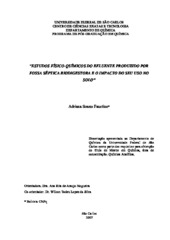Estudos físico-químicos do efluente produzido por fossa séptica biodigestora e o impacto do seu uso no solo
Abstract
The generation of effluent from the sewage treatment is daily increasing then its final disposition represents a mandatory question to be answered. An alternative is its agricultural utilization such as organic fertilizer as a partial substitute of mineral fertilizer. This practice, beyond inherent benefits due to nutrients recycling promotes agricultural water reuse, which is responsible of around 70% of the total water consumption in Brazil. It was developed a research following the stages of the domestic sewage treatment in the anaerobic system called Septic Cesspool Biodigester , developed by Embrapa Agricultural Instrumentation, and also the impact observed in the soil after the application of the treated effluent. Three samplings were done in the different biodigestion chambers which were inoculated with either ovine or bovine manure. These effluents were analyzed according to its original state (liquid), regarding to the determination of some parameters such as conductivity, pH, OBD, OCD and solids content. Other analyses of the effluent were done in the solid obtained after freeze drying of the raw treated effluent. There were determined the mineral composition of the effluent, using the ICP-OES technique. The effluent organic matter was characterized by FTIR, 13C-NMR and EPR spectroscopies and, elemental analysis. The effluent presented alkaline character and significant salts concentration for both systems, high quantity of NNH4 + and low content of N-NO3 -, characteristic of anaerobic systems. The elemental analysis of the solid obtained after the liquid freeze drying, showed that there was not a variation tendency in the percentages of C, H and N during biodigestion process. These values were similar to the either ovine or bovine inoculated systems, and to the different samplings. The effluent presented a quantity of macro e micro nutrients. Through the spectroscopic characterization of the organic matter present in the freeze dried material, it was possible to observe that there were not noticeable variations in the FTIR spectra in the course of the process monitoring. The 13C NMR supplied information about aromatic and aliphatic groups, showing that the effluent presented a high aliphatic content. The soil, classified as Yellowredish Lattosoil with sandy phase, was submitted to the effluent application during three years and was used for the goiaba orchard. Thus, there were compared the effects effluent in comparison of the NPK mineral fertilization as well as the soil of the native forest at the side of the orchard. Determinations of pH, conductivity, macro and micro nutrients content, TOC and LIF were done for the intact soil. Soil HA were extracted and characterized according to their elemental composition, FTIR, 13C NMR, EPR and solution fluorescence. The application of the treated effluent produced an increment in the pH value, mainly in the superficial layer. There was observed nutrients increment in soil submitted to the effluent application when compared with the NPK fertilized soil. Alterations in the humic fraction of the analyzed soil (after effluent application) were observed when compared with the forest and NPK samples. Results obtained by 13C NMR and EPR detected a general diminution of the aromaticity and the humification degree of organic matter, as a consequence of the aliphatic character of the organic matter present in the effluent. The humification degree of HA extracted from the applied effluent soil, determined by LIF and solution, were very similar to the ones observed in the mineral fertilized soil. The effluent supplied macro e micro nutrients in significant quantities to the soil, and it was not observed salinization effect in the analyzed depths. These results show the benefic effect of the utilization of Septic Cesspool Biodigester effluent regarding to the soil fertility.
